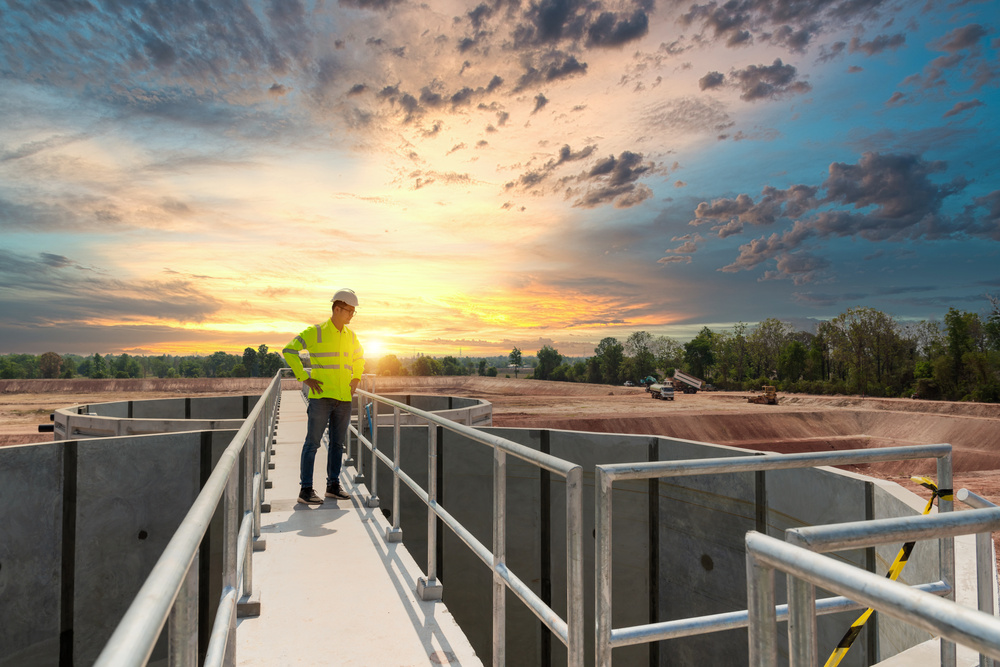An essential part of most construction activities, water is used for mixing concrete, cleaning equipment, washing aggregates, drilling, and dust suppression, among other purposes. However, water pollution occurs if you don’t dispose of products properly, such as concrete, glue, or paints. These contaminants can flow into the water system by entering drains, trickling into soil, and cascading down to lakes or rivers.
Moreover, on rainy days, stormwater washes over loose soil and varying products and materials. It seeps into the construction site, picking up pollutants, including spilled fluids, chemicals, debris, and sediment. These pollutants permeate groundwater, which make it harder to treat. In particular, drinking water may contain some chemicals, such as arsenic and mercury, that could be consumed, leading to serious health problems like cancer.
Water pollution from construction doesn’t just harm people but the environment as well. When the water system gets polluted, marine animals that live in it or drink from it die. Because pollution disrupts the whole ecosystem of plants, animals, fungi, and bacteria, numerous species suffer.
Thus, you must exercise caution when handling construction site materials to prevent catastrophic damage to water sources. Read on to learn how you can reduce water pollution in construction sites.
1. Collect And Treat Wastewater
You can put a system in place for collecting all construction wastewater you use. The collected water can be treated and reused for other purposes within site. You can go a step further and invest in equipment that can help simplify the separation process. For instance, an oil water separator can aid in splitting free-phase hydrocarbons from contaminated wastewater comprising of debris oil.
The water treatment process entails splitting oils and dangling solids from oily wastewater. Such equipment provides a secure way of treating oily wastewater since it has been tested and proven safe for use. Hence, consider purchasing one to handle construction waste.

2. Conceal All Drains
Drains are beneficial in a construction site because they help stop water from flooding into the building structure and roads. However, when you leave the drain system open, there’s a possibility that construction water pollution may directly go into the water system. So, check all drains in the construction site and conceal them.
3. Use Non-Toxic Chemicals And Materials
With the constant advocation for a green environment, there’s the development of non-toxic and no-chemical materials for construction, such as natural lumber, clay plaster, and straw bales that you can use in place of plaster and concrete. These materials are considered environmentally friendly and don’t cause damaging effects.
You can also opt for biodiesel instead of diesel and oil, which often cause significant environmental pollution. Taking these measures will allow you to stem water pollution and reduce your carbon footprint.
4. Ensure Roads To The Site Are Clean
When transporting construction materials within site, materials may spill into roads or footpaths. After you’ve finished using the site for the day, see to it that you clean the places you followed to prevent harmful runoff spills from getting into the water system.
5. Dispose Of Waste Properly
Practice better and safer ways of discarding construction materials to keep them from contaminating the water system. Sort out the trash to give garbage companies an easier time collecting waste. Additionally, verify whether the place they dispose of their waste is safe and legalized by the government. Handle chemical waste carefully and conduct chemical-related activities far from water sources.
6. Store Materials Safely
It’s an everyday practice to leave materials on the construction site. However, this isn’t a good approach because, as mentioned earlier, materials may be washed away and end up in a water source as water pollution from your construction site.
Therefore, you must store the materials you regularly use, such as sand, paint, oil, and cement, indoors safely. In case indoor storage is unavailable, cover outdoor areas with berm and roof or shut in the storage area to block contact with runoff and rain. Another alternative is to use a storm-resistant tarp to cover the materials.
7. Learn About Controlling Erosion
Aside from proper storage, you can enroll in training programs about controlling soil erosion, which helps address water pollution. Filled with organic matter and nutrients plants need, the top layer of the soil serves as a natural filter. It plays an important role in regulating the water flow, fighting diseases and pests, and maintaining a fertile land.
However, construction activities, such as drilling, can ruin the soil. As a result of soul erosion, rocks and sediments get washed away to streams and natural water sources.
To mitigate this problem, you and your staff need to learn various techniques for preventing soil erosion and minimizing land disturbance. Study and understand the risks of erosion in your site and stay updated on regional regulations.
Conclusion
Even though construction sites are known to be a significant source of water pollution, you can find effective ways to resolve the issue. Using high-quality equipment, you can treat water and repurpose it for other uses in your site or ensure it’s clean before letting it drain into water sources.

